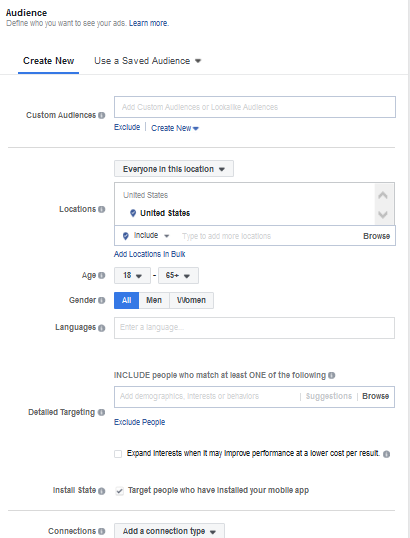You are viewing our site as an Agent, Switch Your View:
Agent | Broker Reset Filters to Default Back to ListA New Guide to Facebook Ad Targeting
November 06 2018
 As the largest social media platform, Facebook offers unique opportunities to connect with potential leads. Unfortunately, due to changes to Facebook's algorithm, companies have been finding it more and more difficult to get organic traffic to their Facebook posts.
As the largest social media platform, Facebook offers unique opportunities to connect with potential leads. Unfortunately, due to changes to Facebook's algorithm, companies have been finding it more and more difficult to get organic traffic to their Facebook posts.
This means that today, Facebook success is largely dependent on creating a strong advertising strategy, which requires a combination of appealing ads and targeting them to the right groups. This, too, is harder now than it used to be, but it's not undoable. There are still several options you can use to target your ideal audience with Facebook ads.
Before we get to targeting, we'll do a quick review on how to create a Facebook ad.
Start by selecting the dropdown arrow at the top right of your Facebook account, then click the "Create Ads" option from the menu.

Next, choose your marketing objective from the list of goals provided, depending on what you want to accomplish. Brand awareness ads are great options for buyers and sellers at different levels of the sales funnel.
Once you've done that, you can decide if you want to use some of the more advanced options, like A/B testing your ads to find out if different pictures/messages/audiences create better results.
Facebook will then walk you through the ad creation process step-by-step, with slightly different options based on the goal you chose. For example, if you choose traffic as your goal, you'll be asked to indicate where you want to send your traffic: a website, app, or your Facebook Messenger account. You'll also be asked to add any images or headlines you want to include in your ad.
After that's done, you'll come to the Audience section. This is where you indicate who you want to see your ads.

Facebook provides several different criteria you can apply to filter your audience, such as "Custom Audiences," locations, and "Detailed Targeting." You can use any or all of these options to pinpoint your audience. Just remember to keep your audience broad enough that you still have a large enough pool of potential clients.
Custom Audience
This section is so you can advertise to people you've already had contact with in some way. This could be your current email list, someone who has visited your website without registering, or people who have engaged with your social posts in the past. Just select the "Create New" option and Facebook's ad manager will display several options to help you hone in on your audience.
You can also use the custom audience option to create a "Lookalike Audience." You can use this option to find people who are similar to those in one of your saved custom audiences. The Audience Size setting allows you to choose how similar you want your target lookalike audience to be to your original audience. I recommend keeping this as small as possible – 1 or 2 percent of the population.
You can use the same technique when choosing the ages and gender of your ad target. You can create a different ad for millennials vs. baby boomers or for men vs. women.
Locations
Choosing where your ad runs is very important. You can run it worldwide, across the country, or as local city or zip codes. Consider creating a seperate ad if you have multiple cities or zip codes you want to advertise in. That way, you can customize your message for each area, even if it's just changing the name of the city or zip code on the ad, it adds a hyper-local feel.
Detailed Targeting
Detailed targeting is where you can really fine-tune your ad audience to target potential buyers, sellers, and referrers. There are two main sections to concern yourself with here: the include and exclude fields. These can be based on demographic data, interests, or behaviors. You can include as many as you like and if someone meets any one of your inclusion criteria, they may be shown your ad. Similarly if someone meets any one of your disclude criteria, they will not see your ad.
You can create hyper-specific ads by pairing your inclusions with a specific zip code. Use the browse option to see a list of popular options. Targeting the income demographic can help you reach out to the top earners in your area or find people in the right range for your geographic farm.
You can also target certain life events, like engagements and newlyweds: occasions that often prelude a home purchase. Parents are another good group to target. With this ad inclusion, it's often a good idea to mention the convenience of the location.
You can also type your own options in. For example, you can also target people who may already be researching homes by adding Homes.com as a factor.
The exclusion option is great when you want to reach new clients, rather than existing ones. Use it to exclude people who have already interacted with you, your website, or social media. Just remember when excluding people to avoid discrimination—this is in line with Facebook's recent removal of 5,000 targeting options to help prevent misuse of advertising on their platform.
Targeting Examples
Before you start entering your targeting data, you should have a clear goal in mind. Know exactly what you hope to achieve and envision the audience that would allow you to meet that goal. Here are a couple examples of how you can target different groups to meet your goals:
Convenience
As much as you would like people to work with you because you're the best agent for the job, sometimes they choose their agent based on convenience. Target the people around your office or areas you frequent so you can demonstrate how easy it would be to get to your office or otherwise get in touch with you.
Presence
You likely already have people coming to your website or people who you've worked with in the past. They're a great target audience. People who have visited your website may be interested in a transaction and just haven't gotten to the agent-selection part of the process. People you've worked with in the past already know and like you and may be a great source of repeat business and referrals. Target them as possible sources of new business or referrals.
To view the original article, visit the Homes.com blog.









